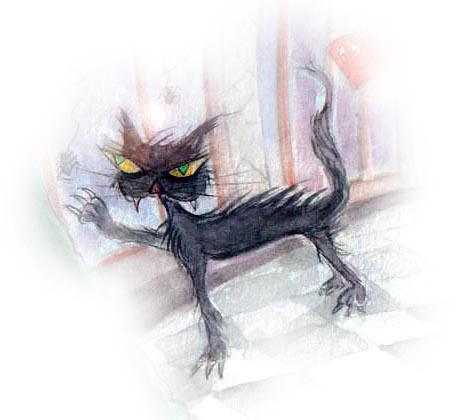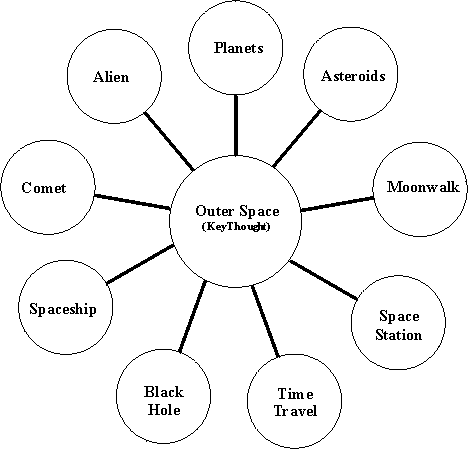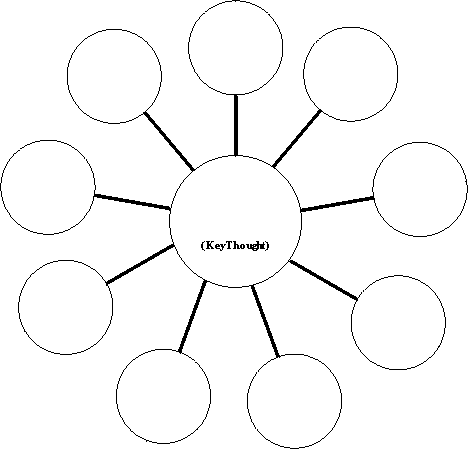

Contents
Septimus Pitt
(poem)The Grumbloid Rap
(poem)Notes for Teachers
(About the book)Gathering Thoughts
(some ideas for using
the Worksheets)Worksheet 1
(The Cosmic Postman -
Outer Space)Worksheet 2
(Michael and Billy -
Anti-sectarianism)
Back
to Brian Whittingham's
website
THOUGHT
GATHERING
The
following section is set up mainly for viewing on the web.
You can
download a printable
and easier to use version
of this worksheet
click
here for the MS
Word document
YOUR
FIRST THOUGHT IS RARELY YOUR BEST
Emphasise this to learners and qualify the statement with the observation that even though it's rarely your best, it's important to get it down so you can make room for other thoughts.
Example exercise:
Ask learners to prepare to immediately write down the answer to a question you are going to put to them.
Pose the question, 'What is the first vegetable you can think of?' You can adapt this to any subject. First football team, first planet etc.
Approx. 50% will answer carrot. Tell them not to tell you their answers till they allow you to guess.
Write the word carrot on the board as if you're reading their minds then guessing their answer.
Re-emphasising YOUR FIRST THOUGHT IS RARELY YOUR BEST ask them again, to name a vegetable. This time, they should take a few seconds thinking about it with the aim of coming up with a different answer from others. To come up with a more original idea than others, that is the goal. This exercise can be adapted into a variety of formats. E.g. pairs or teams can be seated apart from each other and challenged to come up with original answers.
There should be a more varied response this time with learners giving more thought to their answers.
A UNIQUE VIEWPOINT IS BEST!
Emphasise this to learners by asking how they might look at their thumb, closely, differently and from an unusual point of view. They will answer with their eyes, microscope, magnifying glass etc.
Put forward the example from the film Dead Poet's Society where the teacher, played by Robin Williams, gets pupils to stand on desks so they can see the classroom from a unique point of view.
Example exercise:
Give the learners turns of looking at their thumbs through a magnifying glass and describing what they see.
Tell learners that this is an important element of poetry, looking at the world from a unique point of view.
THOUGHT-CHART (EXAMPLE)
A thought-chart is made up from thought bubbles and is a method of creating a word-store relative to a specific KEY-THOUGHT.
Example exercise:
POEM.................................................. THE COSMIC POSTMAN
KEY-THOUGHT .................................OUTER SPACE
- From the book, SEPTIMUS PITT & THE GRUMBLEOIDS, various learners should read the same poem of choice. It's important the poem is read a few times at least. The learner group should then agree on a key-thought for the centre circle (ref. example).
- Fill in the surrounding circles with words that can be connected to the key-thought. (ref. example).
- By using this method, build up a word store around the key-thought. It can be based on any key-thought the teacher / learners, decide.
- You can expand by adding more circles of your own. REMEMBER, THEY MUST ALWAYS CONNECT TO THE CENTRE! THIS HELPS MAKE SPACE IN YOUR HEAD FOR YOUR NEXT THOUGHT.
- Now you are ready to work your way through the worksheet tasks referring to, or adding to, your THOUGHT-CHART, as you go along.
- Refer to the following example THOUGHT-CHART.
- The THOUGHT-CHART method can be done by individuals, pairs, groups or the whole class.
COSMIC
POSTMAN THOUGHT-CHART
The
book, Septimus Pitt, is due to be published by Luath
Press and launched in Feb. 2007 at the
AYE
WRITE LITERARY FESTIVAL in the Mitchell library.

